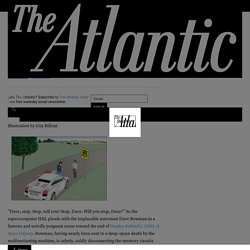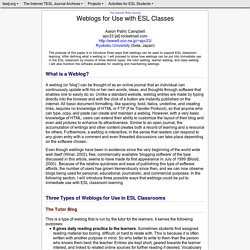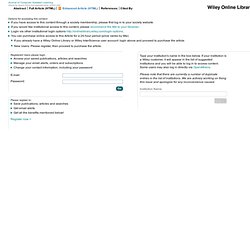

annehanzy
JTIE - Journal of Technology and Information Education (Casopis pro technickou a informacni vychovu) Educator Consultant Author. MAREŠOVÁ_Hana.pdf (application/pdf objekt) (Page 2 of 18) - Facebook: Classroom Tool for a Classroom Community? authored by Towner, Terri. and VanHorn, Abigaile. The Graphic - Faculty and Facebook. AUDREY REEDNews Editor Even though students dominate Facebook, faculty and staff are also in the online mix.

Whether it’s to get to know students, keep in touch or assign class work, professors have utilized the online networking site. By searching for faculty and staff on the Facebook, more than 65 user names come up. Staff members from Seaver Dean David Baird to Associate Dean of Students Tabatha Jones to professors from nearly every division all have Facebook accounts. While the majority only have the basic information like name and e-mail address filled in, other professors use the site much like students. But in doing this, many professors say that they must exercise caution in what they look at and what they put online when using the site. Science professor Douglas Mulford joined Facebook when he was overseas in Florence, Italy. “I have to be careful about it,” he said. However, Mulford does see some use in the site. WhyYouthHeart.pdf (application/pdf objekt)
Faculty Ethics on Facebook – The Collaborative Project ‹ The Student Affairs Collaborative. Erm0721.pdf (application/pdf objekt) UCALL Conference Keynote: Computer Assisted Language Learning: Where are we now and where are we going? by Graham Davies. Computer Assisted Language Learning: Where are we now and where are we going?

By Graham Davies This article was first presented as a keynote paper at the UCALL Conference, University of Ulster at Coleraine,14-15 June 2005, and in then in revised format at the conference on E-Learning and Japanese Language Education: Pedagogy and Practice, Oxford Brookes University, 31 March to 1 April 2007. It was presented again in revised format as a guest lecture at the University of Warwick, 3 October 2007.
An earlier article with the same title but different content was published at the Futurelab website in 2003: Links checked 10 February 2012. Untitled. The list of common myths about e-learning presented below is based on a number of past papers and publications, as listed at the end of the page, but has been added to over time. ► E-learning saves money.

It doesn't. It's resource- and labour-intensive for both staff and students. Its advantages are pedagogical, (multi-)cultural and perhaps geographic, but not economic. However, while it is a mistake to see e-learning as a cheap alternative to face-to-face classes, there is no doubt that e-learning courses can be economically viable, as is currently being demonstrated all over the world. Ggworkpackageii.pdf (application/pdf objekt) Engines for Education - Welcome. Socratic Arts - Welcome. Dustin. Dustin We have built a number of social simulations at ILS that provide learning by doing environments.

Dustin is an example of a simple simulator built to help students learn a foreign language through learning by doing. Dustin (named after Dustin Hoffman because its goal is to allow you to act your part as a foreign language speaker by teaching you to know your lines) was developed for use by foreign employees of Andersen Consulting. As in any good acting situation, the scene must be set, and the scene for Dustin is a training center in St. Charles, Illinois. Engines for Educators. 9705-12, Informační společnost v číslech, obsah. Výsledky vyhledávání. Is09_f.pdf (application/pdf objekt) JT010NPvyukyCJnaNet.pdf (application/pdf objekt) Is Google Making Us Stupid? - Nicholas Carr. Illustration by Guy Billout "Dave, stop.

Stop, will you? Stop, Dave. Will you stop, Dave?” So the supercomputer HAL pleads with the implacable astronaut Dave Bowman in a famous and weirdly poignant scene toward the end of Stanley Kubrick’s 2001: A Space Odyssey. I can feel it, too. I think I know what’s going on. For me, as for others, the Net is becoming a universal medium, the conduit for most of the information that flows through my eyes and ears and into my mind.
I’m not the only one. Bruce Friedman, who blogs regularly about the use of computers in medicine, also has described how the Internet has altered his mental habits. Anecdotes alone don’t prove much. It is clear that users are not reading online in the traditional sense; indeed there are signs that new forms of “reading” are emerging as users “power browse” horizontally through titles, contents pages and abstracts going for quick wins. Reading, explains Wolf, is not an instinctive skill for human beings. New net-based collaborative learning activities. Virtual collaboration, ‘perezhivanie’ and teacher learning: A socio-cultural-historical perspective. Innovating Teaching and Learning Practices: Key Elements for Developing Creative Classrooms in Europe.
Enhancing Online Student Engagement. Understanding personal learning networks: Their structure, content and the networking skills needed to optimally use them. Campbell - Weblogs for Use in ESL Classrooms. The Internet TESL Journal Aaron Patric Campbellapc33 [at] rocketmail.

University (Seta, Japan) The purpose of this paper is to introduce three ways that weblogs can be used to support ESL classroom learning. After defining what a weblog is, I will proceed to show how weblogs can be put into immediate use in the ESL classroom by means of three distinct types: the tutor weblog, learner weblog, and class weblog. I will also mention the software available for creating and maintaining weblogs. What is a Weblog? A weblog (or 'blog') can be thought of as an online journal that an individual can continuously update with his or her own words, ideas, and thoughts through software that enables one to easily do so.
Even though weblogs have been in existence since the very beginning of the world wide web itself (Winer, 2002), free, commercially available 'blogging software' of the type discussed in this article, seems to have made its first appearance in July of 1999 (Blood, 2000). The Tutor Blog. DNA/How to Stop Worrying and Learn to Love the Internet. This piece first appeared in the News Review section of The Sunday Times on August 29th 1999.

A couple of years or so ago I was a guest on Start The Week, and I was authoritatively informed by a very distinguished journalist that the whole Internet thing was just a silly fad like ham radio in the fifties, and that if I thought any different I was really a bit naïve. It is a very British trait – natural, perhaps, for a country which has lost an empire and found Mr Blobby – to be so suspicious of change.
But the change is real. I don’t think anybody would argue now that the Internet isn’t becoming a major factor in our lives. However, it’s very new to us. Nik's Learning Technology Blog. Web 2.0 Tools for Teachers. Bloom's Taxonomy Blooms Digitally. 4/1/2008 By: Andrew Churches from Educators' eZine Introduction and Background: Bloom's Taxonomy In the 1950's Benjamin Bloom developed his taxonomy of cognitive objectives, Bloom's Taxonomy.

This categorized and ordered thinking skills and objectives. Bloom's Revised Taxonomy In the 1990's, a former student of Bloom, Lorin Anderson, revised Bloom's Taxonomy and published this- Bloom's Revised Taxonomy in 2001.Key to this is the use of verbs rather than nouns for each of the categories and a rearrangement of the sequence within the taxonomy. PUB7101.pdf (application/pdf objekt) Different worlds? A comparison of young people's home and school ICT use - Kent - 2004 - Journal of Computer Assisted Learning. Options for accessing this content: Type your institution's name in the box below.

If your institution is a Wiley customer, it will appear in the list of suggested institutions and you will be able to log in to access content. Some users may also log in directly via OpenAthens. JCAL_Different_Worlds_paper.pdf (application/pdf objekt) 2006-3pp157-167.pdf (application/pdf objekt) 2007JALNOnlineCommunityofInquiryReview.pdf (application/pdf objekt) Eh203mg.pdf (application/pdf objekt) The design and development of a wiki task in undergraduate education: retrospects and prospects. Web 1.0 technologies.

As opposed to the first generation of web tools whichreplicated on-line traditional, delivery-based modes of teaching, the secondgeneration of Web tools presupposes the active participation of students/users. This makes web 2.0 technologies particularly appealing because they areperfectly compatible with constructivist conceptions of learning according towhich students actively participate in the learning process. Moreover, the focuson communication and collaboration which many web 2.0 tools afford makesthem even more promising from a constructivist point of view. The de factoparticipation of students, which web 2.0 technologies require, enables innovativeconstructivist practices where students do not simply consume learningmaterials compiled by instructors but actively contribute to the creation andprocessing of these materials (Palloff & Pratt, 2007; Mason & Rennie, 2008).
Wikis in education Wikis are amongst the most popular and well-known Web 2.0 tools. A. Haythornthwaite. For many years, discussion of online learning, or e–learning, has been pre–occupied with the practice of teaching online and the debate about whether being online is ‘as good as’ being offline. The authors contributing to this paper see this past as an incubation period for the emergence of new teaching and learning practices. We see changes in teaching and learning emerging from the nexus of a changing landscape of information and communication technologies, an active and motivated teaching corps that has worked to derive new approaches to teaching, an equally active and motivated learning corps that has contributed as much to how to teach online as they have to how to learn while online, with others, and away from a campus setting.
Li_2012.pdf (application/pdf objekt) Behaviorism vs. Constructivism in the Technological Secondary Education Classroom - Theories of Educational Technology. By Andrea K. Ebert Abstract Behaviorism and Constructivism are two of the predominant educational theories that form the basis of many of today’s educational technology tools in the secondary classroom. In the research currently being conducted on the subject, there is an obvious shift to a more Constructivist way of thinking when it comes to implementing classroom technologies.
However, there are still arguments in favor of tools that are more Behaviorist in nature. The Influence of Constructivist E-learning System on Student Learning Outcomes - ProQuest Education Journals - ProQuest. Marginalia Web Annotation. Andrew Feenberg, Cindy Xin & Geoffrey Glass Introduction This manual is designed to provide insight into the “virtual classroom” and techniques for effective online teaching. We begin with a comparison of online discussion forums to face-to-face social interaction. We then introduce an approach to moderating forums, and provide some practical advice for managing them with the help of Marginalia. The Impact of Learning Styles on Interactivity in Asynchronous e-Learning - ProQuest Education Journals - ProQuest. Internet project-based learning environment: the effects of thinking styles on learning transfer - Lee - 2004 - Journal of Computer Assisted Learning - Wiley Online Library.
Internet Linguistics.